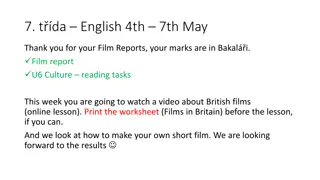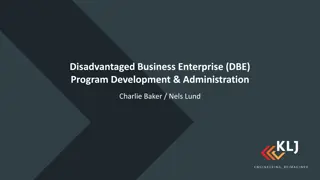Asian Americans in Underground Filmmaking: Punk, Anti-establishment, and DIY Mentality
Explore the world of Asian American filmmakers in underground cinema creating thought-provoking films with punk influences, anti-establishment themes, and a strong DIY mentality. Not confined by traditional norms, these filmmakers challenge the status quo and express creativity outside mainstream Hollywood. Learn about influential figures like Jon Moritsugu, Gregg Araki, Rico Martinez, and Roddy Bogawa, who push boundaries and shape the landscape of guerrilla filmmaking.
Download Presentation

Please find below an Image/Link to download the presentation.
The content on the website is provided AS IS for your information and personal use only. It may not be sold, licensed, or shared on other websites without obtaining consent from the author.If you encounter any issues during the download, it is possible that the publisher has removed the file from their server.
You are allowed to download the files provided on this website for personal or commercial use, subject to the condition that they are used lawfully. All files are the property of their respective owners.
The content on the website is provided AS IS for your information and personal use only. It may not be sold, licensed, or shared on other websites without obtaining consent from the author.
E N D
Presentation Transcript
ASIAN AMERICANS IN MEDIA Week 10: Contemporary Topics I Punk & Underground Films
Key Terms: Stereotype and realism Punk Underground films Guerrilla cinema Jon Moritsugu, gregg araki, Rico Martinez, Roddy Bogawa
Underground & Guerrilla Filmmaking: Independent/low budget productions: but not the definition ( indiewood ) that is used in mass media today. Anti-establishment: reacting against the status quo, anti-Hollywood, produced outside the industry and public television system. Underground cinema: inspired more by Kenneth Anger, U.S. avant-garde cinema
Jean Luc Goddard and the French New Wave, more so than 1st and 2nd generation Asian American filmmakers. Also influenced by and in dialogue with other aspects of underground culture: music (punk rock), club scene, fashion, zines (Moritsugu interviewed in GB#1) Punk rock and zines DIY mentality A generation of filmmakers all educated in university media/art/theory programs.
gregg araki (read his article in MTI P.68), Jon Moritsugu, Rico Martinez, Roddy Bogawa. Their films do not necessarily address Asian American issues, or have Asian Americans in them. Intertextuality they often end up using the same actors, producers, production designers, etc. (i.e. their friends) Andrea Sperling, who produced Terminal USA, also produced many of gregg araki s films
like Totally Fucked Up (1996) and Doom Generation (1995).
Jon Moritsugu Born 1965 in Hawaii, Moritsugu has been making films since 1985 Educated at Brown University s Semiotics program His web site
Currently based in Santa Fe, NM (?), continues to make underground films (unlike Araki, who graduated to making bigger budgeted indiewood features) His most recent film is Pig Death Machine (2013), other films include: Sleazy Rider (1988), Hippy Porn (1991), Mod Fuck Explosion (1994), Fame Whore (1997), and Scumrock (2002).
Even though Jon is married to a woman, Amy Davis, with whom he collaborates, his work share a lot of the qualities with queer cinema, including parody, outrageousness, infatuation with popular culture, the importance of music, drag, and fascination with shock value.
His interview in GB also touched on issues of funding, identity politics, and how an independent / underground Asian American filmmaker survives and makes his / her work.
Mommy, Mommy, Wheres My Brain? (1986) Dir. Jon Moritsugu
Discussion Questions: Have we watched any films like this in class thus far?
Discussion Questions: Have we watched any films like this in class thus far? If so, compare / contrast?
Discussion Questions: Have we watched any films like this in class thus far? If so, compare / contrast? What about outside of class?
Discussion Questions: Have we watched any films like this in class thus far? If so, compare / contrast? What about outside of class? How would you describe this type of cinema (in terms of context, inspiration, intended audience?)
Discussion Questions: Have we watched any films like this in class thus far? If so, compare / contrast? What about outside of class? How would you describe this type of cinema (in terms of context, inspiration, intended audience?) What about Asian American representation? Is this an Asian American film?
Terminal USA (1993) Tien Le Nina Lee
Did you like/not like the film? Why or why not? How is this film similar or different to both the films we have watched in class as well as Mommy Mommy Where s My Brain? Clip of kids coming home (2:58-4:30) vs. ending 48:53- 49:54
How can we apply the previously discussed concepts of dismantling stereotypes and refunctioning representation to Moritsugu s alternative usage of stereotypes in Terminal USA? Shothat and Stam challenge the preoccupation with stereotype analysis and the idea of representation realism trapping people into image analysis rather than discursive analysis. How does Moritsugu s film support Shothat s and Stam s call to critique both image and voice question the genre of realism in regards to ethnic representation?
Moritsugu was awarded a grant from PBS to create and show his film, thus forcing him to create a censored version of Terminal USA In his Giant Robot interview, Moritsugu talks about the preference for certain kinds of films based on minimum quota-filling ideals. How can restrictive support (funding, acknowledgement from film festivals) affect the creation of content? Eurocentric asian american representation that is the only kind of representation that is supported and funded.. does his film critique Asian American film ?























